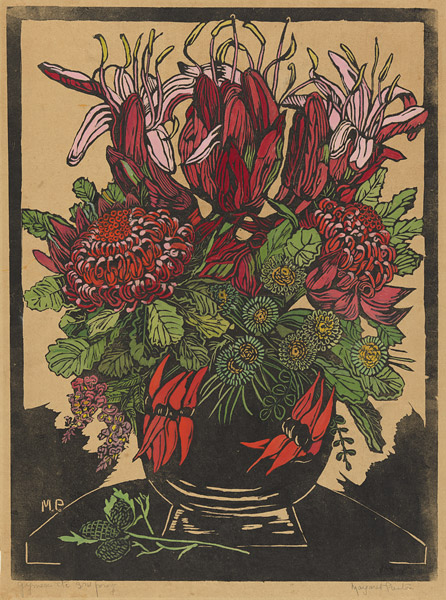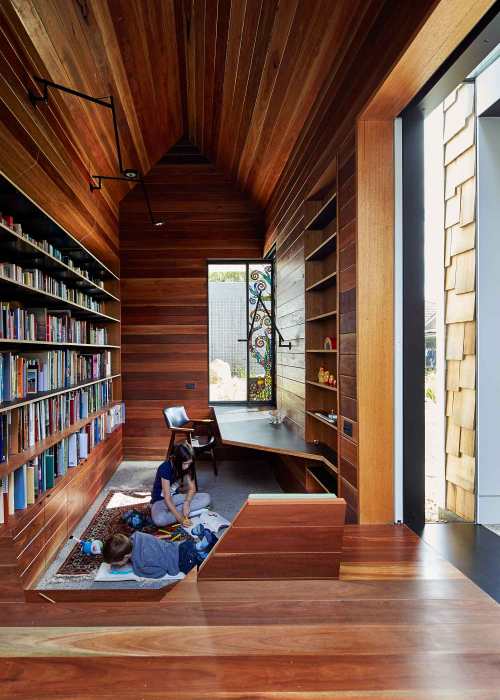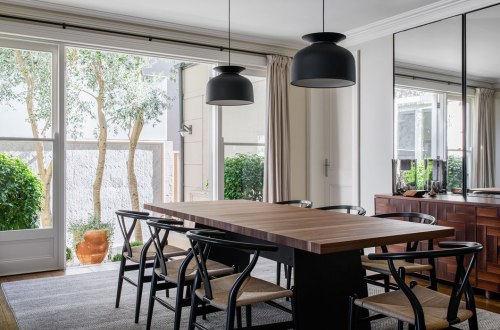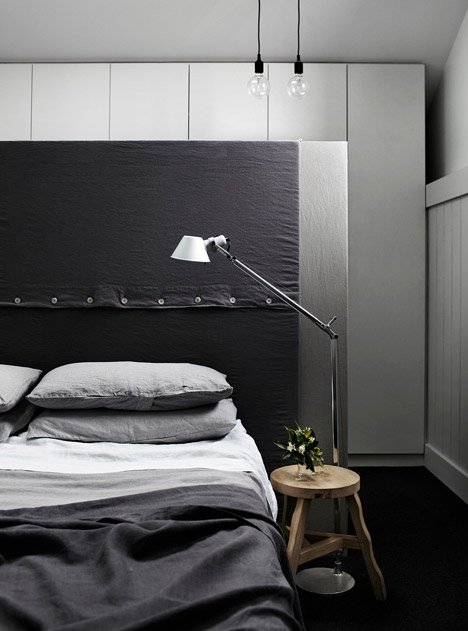Inside Line

For a nation of people so in love with the outdoors, Australians have always had a sharp eye for interior design.
In the early days, of course, décor was largely imported; and between the gold rush and the wool boom, money was little object. The prominent Barr Smith family, then Australia’s wealthiest, led the charge, and between 1884 and 1929 furnished seven grand homes around Adelaide entirely in William Morris designs…and along the way, amassed one of the premier collections of decorative arts outside Britain.
But home decoration was not just for the elites. Australian artists and designers were avidly applying Modernism to domestic interiors in the pages of The Home magazine, first published in1920. The most influential of these was Margaret Preston, whose vigorous graphic prints of native flora and Aboriginal motifs were widely published in women’s magazines. In 1929, readers of Women’s World were even advised to keep and frame Preston’s covers ‘as charming pictures…just the decorative asset we need for Australian homes.’

That same idea of place still winds like a silver creek through Australian interiors, but never in an obvious way. Contemporary Australian design has matured into a sophisticated but underplayed approach, always with an eye to innovation, character and subtle references to the natural environment.
Design expert Jan Henderson feels that the seeming lack of an ‘Australian style’ has become Australia’s signature. ‘That plurality is our real strength,’ she says. ‘We’re not constrained by set styles that are almost clichés. Australian design can take the best from many looks and reinvent it for all the ways Australians live.’
Today, we demand more of our homes than ever before. Not only do they have to be offices, hotel kitchens, education centres, gyms, and technology hubs, they need to energise and provide respite. They must offer warm social spaces and moment of private restoration for their busy inhabitants, and more and more people understand that interiors play a crucial role in creating a sense of individuality and well-being.
But creating the perfect home interior doesn’t happen by accident. Far from being an extravagance, engaging a professional decorator or interior designer is now simply seen as the smart choice.
Unquestionably, hiring a professional has numerous benefits. Foremost is obviously their experience- design that represents quality takes education and time, and rather like learning to appreciate fine food and wine, there are no shortcuts. Designers are experts at creating and utilising spaces, and will arrive at creative solutions most people would never imagine. Their knowledge of decorative styles helps resolve mismatches into a harmonious whole, and their understanding of design psychology creates positive responses to domestic spaces.
An interior designer will project manage every stage, helping to minimise costs, time and disruption, and in cases involving structural work, help navigate building regulations. Many work closely with architects to plan distinctive residences from the ground up, and have access to resources that are simply not available to the public. An entire industry of manufacturers, restorers and specialist importers deals predominantly, if not solely, with designers, dramatically expanding the creative possibilities for your home.

A good designer will also have the contacts for skilled craftsmen and women who can create bespoke cabinetry and furniture that will last a lifetime, while professional decor and well-designed builds can add substantially to the value of your home…not that you’d dream of selling.
When choosing a designer, it pays to do the legwork and develop an awareness of quality design. The Design Institute of Australia a starting point; from there, design experts recommend shopping around. Online portfolios are an accessible way to gauge a designer’s aesthetic and flexibility, and a well-established profile and strong history is a good indictor of a designer’s calibre, often the key to a successful project.
Jan Henderson, co-Editor with Gillian Serisier of inside Interior Design Review, emphasises the importance of finding a designer you resonate with. ‘Design is a relationship you need to build, so you need to find someone on your wavelength, to bring ideas out of you that you didn’t know were there,’ she says.
With inside hosting the Interior Design Excellence Awards, Henderson has a valuable perspective what constitutes exceptional design. Now in its thirteenth year, IDEA is Australia’s largest and most successful design awards, adjudicated by a panel of leading professionals representing a broad cross section and deep understanding of the industry.
‘It’s a difficult decision,’ she says, ‘and only getting harder with the high calibre of entries. The jury looks for a special commitment to designing for the needs of the client, in a way that brings together pure talent, and eye for detail and a professional habit. Standout design thinks outside the box.’

It’s certainly a description that aptly summarises Arent&Pyke, 2015 IDEA Residential Decoration winners. Although working on commercial and hospitality projects in Australia and overseas, Sydney duo Juliette Arent and Sarah-Jane Pyke prefer the warmth and generosity of residential projects.
‘People yearn to have a connection to their spaces,’ Arent says. ‘A large part of our process is about distilling the ideas and emotions they associate with home, their families and their interests. We work closely and nurture clients through the whole project, so releasing that joy for them is important to us.’
Arent and Pyke spend a great deal of time learning how their clients actually use their spaces. ‘There are common threads in family homes. Practicality and making spaces to be together is important, but there also needs to comfort and finesse, special moments in the everyday that are unexpected, but still feel natural. That’s what makes someone feel the house is truly theirs, not a page from a magazine.’

Figtree house, their winning residence, is an elegant testament to their approach. The beachside terrace in Sydney’s Eastern suburbs is a far cry from the industrial space the clients initially wanted. Arent and Pyke lightened the stately Victorian lines with colour, layered lighting and kept a thread of industrial design throughout. The home’s different moods are shaped by the spaces- the deep navy and white of the sitting room, for example, is composed but laid-back, achieved with a mix of vintage and contemporary furniture. The family and dining spaces, on the other hand, are flooded with leaf-filtered sunlight playing on soft colours and natural textures.
Arent and Pyke delight in stretching themselves and their clients. ‘We never want to be formulaic, and we always want to give the client more than they ever expected.
‘Our clients, their ideas and the things they love and want around them, are our starting points. We take them on a journey, and we make sure they enjoy themselves and learn from it. It’s always gratifying to see them develop their own ideas, and get the confidence to carry on for themselves.’

Planting the right seeds and fully engaging with the client is all about building trust and for Sydney-based Amber Road Design, whose Cronulla Residence won it a Commendation in the 2015 IDEA awards, that engagement led to a significantly expanded project.
Initially briefed to source furniture for a modest waterfront weatherboard cottage in Cronulla that would ‘introduce sculptural and artisanal beauty’, the project then went on to encompass internal building works, custom joinery, selection of artwork and working with a paint consultant to provide a palette that improved light reflection to illuminate the various spaces.
The end result combining iconic furniture pieces, beautiful shapes and lines and impeccable craftsmanship is a delightful expression of the client’s request to ‘keep it as unpretentious and simple as possible’.

Interior design extends well beyond colour and texture, as architect Steven Whiting and creative director Carole Whiting eloquently attest, to encompass creating whole new interiors. And Whiting Architects’ Kerferd house, winners of the 2015 Australian Interior Design Awards: Residential Decoration, is a perfect example.
For the project, the five-person team responded to the surrounding architectural language with an understated extension to the existing double-fronted Edwardian red brick, that creates what Whiting describes as ‘precincts’- distinct areas for living that integrate with the structure. He notes that ‘good architecture doesn’t need more space- it does more with the space it has.’
It’s impossible to separate the functional from the decorative in the Kerford home; rooms fold origami-like into one other. Every element serves multiple functions. The restrained palette of natural materials, tactile layers of softened white linen and wool and textured blacks makes inhabiting the house a meditative, cocoon-like experience.

Drawing on their background as filmmakers, the Whitings regard the interiors as a landscape in itself, constantly changing with light and time- requiring an extraordinary level of trust and commitment from clients.
‘We take a lot of time getting to know our clients, and design completely around their life and habits,’ says Steven Whiting. ‘We make them an integral part of the process.’ Carole Whiting laughs. ‘They have to trust us, we’re literally in their sock drawers.’
But it’s an approach that clients find satisfying and rewarding, in ways that can’t be measured in cost or construction. Whiting describes Kerford as a house that makes you stop, and think, experience and look.
‘The light frames views, sets up spaces with the way the sun hits, and creates a mood and feeling. In the longer term, the natural materials will age, weather and mellow. It’s profound and serious, but also lets you enjoy new discoveries. It’s a house that shows rather than tells.’
Published Il Tridente 2016
